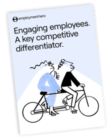Should we stop talking about generational differences in the workplace?
Generational myths often have stereotypes that we unconsciously lean on. Can this be harmful in the workplace?

Welcome to the modern workplace. Where we seem to have labels for everything.
Looking for one in particular? The options are endless. From ones to highlight your gender in titles such as Female Founder – while the male equivalent remains genderless, to labels for generational differences to highlight age and workplace ideals.
Even though the labels we currently use to highlight generational differences in the workplace are relatively modern, the concept of generational gaps are certainly not new.
We know that differences exist amongst all our age groups but our fascination with generational differences can be dated back to before we were unable to buy houses because of avocado toast loving millennials or what Calvin Harris thought was Acceptable in the 80’s.
In fact, the term generation itself can be dated as far back to the 1800s. It’s thought to have come from the desire to explain the differences we see amongst family members. But it wasn’t until sociologist Karl Mannheim’s infamous paper in 1928 that modern day theories really started developing.
With so many unprecedented changes such as a global pandemic, a global resignation and the global movement to push for more work from home rights bringing us all together, is it time we stopped talking about generational differences in the workplace?
To understand the impact of these changes on employee expectations, you can read about how Covid-19 has transformed the workplace here.
But first, let’s address the five generations in the current workforce
With so many generations in the workplace, who are the younger workers? What timeframe does the generational gap highlight?
We’ve got you covered with some definitions so that we can start openly talking about it:
1. The Silent Generation
Someone born between 1926 and 1945, who has lived through the Second World War. The name comes from an article in Time magazine from the 1950s.
2. Baby boomers
Someone born between 1946 and 1964 – the years following the Second World War. They’re called baby boomers due to the temporary marked increase in birth rate. Just don’t say “OK boomer” to them.
3. Generation X
Generation Xers are people born between 1966 and 1980. Gen Xers grew up in the time where technology was advancing but not the way we know it today.
4. Millennials (also known as Generation Y)
Gen Y are born between 1981 and 1994/6 (depending on what source you use) and are also known as the MySpace or supposed avocado-fanatic generation.
5. Generation Z
The emerging generation in the workforce. Gen Z were born between 1997-2012. In fact, we have a Generation Z in the workplace report for you to check out if you want to learn how to engage with your gen z employees.
Generation Alpha has also recently come up in the last few years to categorise those born between 2011 and 2025 but for the purpose of this blog we’ll be focusing on these 5 generations as they’ve not quite entered the workplace yet.
Do age groups in the workplace matter?
If there ever was a double edged sword, this question would be it.
After all, where there are presumptions, there is a degree of ageism which can be detrimental.
However, being aware of age groups in the workplace can also be helpful. For instance, it can help you understand how best to engage with your employees, or choose that team building activity. It can also help you understand different work styles and communication styles people have on your team. For more insights, you can read about managing a multigenerational workforce here. Work from home is something digital natives have embraced
Work from home is something digital natives have embraced
Depending on what stage of your career you’re at, age groups can work against you when it comes to looking at something like retirement benefits.
Different generations have different expectations based on the type of financial planning they’ve been taught. There are other responsibilities to consider with each age group too. Broadly speaking, younger age groups are more likely to care more about student debt and HR professionals will have to work out student loan payments. Other generations may be more interested in the benefits packages a role offers.
Why is it important to understand generational differences in the workplace?
Generational differences are often too generalised, presumptuous – and should be taken with a pinch of salt. You needn’t look far to see why either – harmful sayings such as ‘you can’t teach an old dog new tricks’ should not have a place in modern day society when we’re seeing, for example, Baby Boomers starting to embrace the use of social media.
In her article for LSE, Sharon Raj sums it up well, saying, “Biased beliefs or assumptions held by others mean that our physical characteristics, for example gender, appearance, or ethnicity, have the potential to be a huge advantage or disadvantage in the workplace.”
She believes that, “One such characteristic with the potential to affect virtually all employees during their working lives is age.” And we’ve seen how age can affect us change drastically over the last decade, too.
In the traditional workplace, this mattered when it came to the number of years of experience each role required and created a particular dynamic amongst those at the top in leadership positions. Company loyalty also mattered, which meant that young adults would have a slimmer chance of promotions when up against their older counterparts creating a wider generational diversity gap.
Today, it is essential to understand both Millennials and Gen Z (Zoomers) to foster a conscious workforce. You can read more about it here.
Now, thanks to access to learning platforms such as Youtube, Masterclass, and Skillshare, upskilling and development opportunities are easier to access. As a result we’re seeing people of different ages, at different stages of their career. There’s been an increase in the use of career coaches too who have seen a rise in the number of clients they have from a younger age group.
Founders of today’s startups are getting younger too, thanks to the use of social media which has turned side hustles into seven figure empires creating room for Generation Z and Millennial aged company founders.
In the past few years, Forbes was under fire for not managing generational differences and showing potential age discrimination when it came to their infamous 30s under 30 list that comes out every year.
Initially designed and created to celebrate bright, young entrepreneurs it raised the important question of what happened to celebrating seasoned entrepreneurs? Those who found their calling later on in life? To answer this question after being heavily criticised, they recently created the Forbes 50 under 50 list in 2021 to celebrate the older generation.
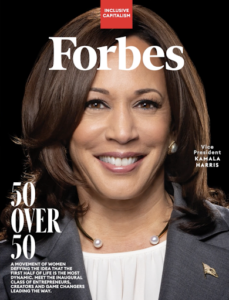 Image Credit: Forbes
Image Credit: Forbes
Perhaps this shows us that it is important to embrace the different generations in the workplace, rather than lean on it as a tool to divide our workforce further. There may be key differences between the younger generations and older employees but we should not make that the focus of any strategies that are put in place.
Just take a look at these outdated myths that have been toxic in the modern multigenerational workplace.
What are common harmful myths about the different generations at work?
If you want to build an inclusive and dynamic team, chances are you’re aiming to create a positive work environment that embraces all generations. However, in a multigenerational workforce there are some common myths that may be harmful to both your younger employees and the older generations.
Let’s take a look at some outdated generational myths that are holding workplaces back and uncover the unique styles of each generation that make us stronger, together.
Myth no. 1: Millennials are lazy
One of the most popular work related myths about millennials is the troubling implications that millennial employees are lazy. It came to surface thanks to many of them often job hunting, unable to buy a home, and their fight for a better work-life balance.
But they’ve also been dubbed heroes, too.
In fact, there’s a piece about how Millennials and Gen Zers are the Young People [who] Are Going To Save Us All From Office Life which debates how, “They [could be] among the first to understand the proper role of work in life – and end up remaking work for everyone else.”
Millennials might be on to something – perhaps what we’re all looking for is flexibility. And if anything, the Covid-19 pandemic has taught us that being expected to work 24/7 can be detrimental to our productivity and mental health and flexible work schedules allow us to optimise our productivity.
Myth no. 2: Your work hours reflect how hard you work
This myth is popular amongst older workers as it alludes to how the traditional workplace once was.
Depending on what industry you were in, in some cases, it used to be unheard of for a direct report to leave before their boss. It comes from the old saying that you must “work hard and you’ll succeed.”
We believe this is outdated and that flexible work is the way to go. In fact, we wrote a blog on 7 outdated work practices that should go out the door, alongside this one.
Avoid embracing this myth by changing your mindset towards what good productivity should look like. There is a fine line between productivity and burnout – make sure that efficiency is embraced and not rewarded with more work to avoid burning out your team.
Myth no. 3: You can’t teach an old dog new tricks
This is arguably one of the worst sayings, ever.
With the advancement of technology, the saying has come back up in recent years as today’s workforce become more digitally literate, leaving some of the older generations behind. Or so they say.
Older generations have been embracing TikTok. Ever heard of Iris Apfel? Her TikTok channel has over 17.4 million views, proving that given the chance, an older employee can embrace new technology, too.
 Image Credit: Iris Apfel
Image Credit: Iris Apfel
Myth no. 4: Meet Gen Z – the wellness generation
Bobby Duffy’s new book on The Generation Myth dubs Gen Zers the ‘wellbeing generation’ thanks to the some data which shows a drop in the number of smokers who enter adult life as a smoker, in comparison to Millennials when they were at the same age.
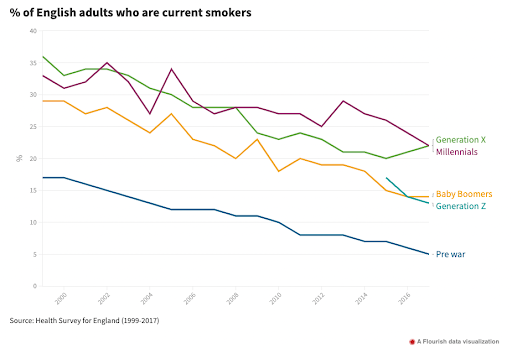 Image Credit: Bobby Duffy
Image Credit: Bobby Duffy
Duffy believes that instead of looking at baseless stereotypes, we should focus on more rigorous generational analysis and cites Covid-19 as “one of the most powerful tools for understanding how individuals and societies change as a truly generation-shaping event.”
Use your awareness of generational differences to be inclusive, not exclusive
Instead of stopping the conversation all together, embracing awareness is key to successfully managing different generations working together and creating a healthy work environment. After all, there are a lot of life experiences and stories we can learn from all five generations.
There’s a fine line between being mindful, and presumptuous. Download our workplace culture bundle to learn more about building healthy work cultures.
Related Resources
-
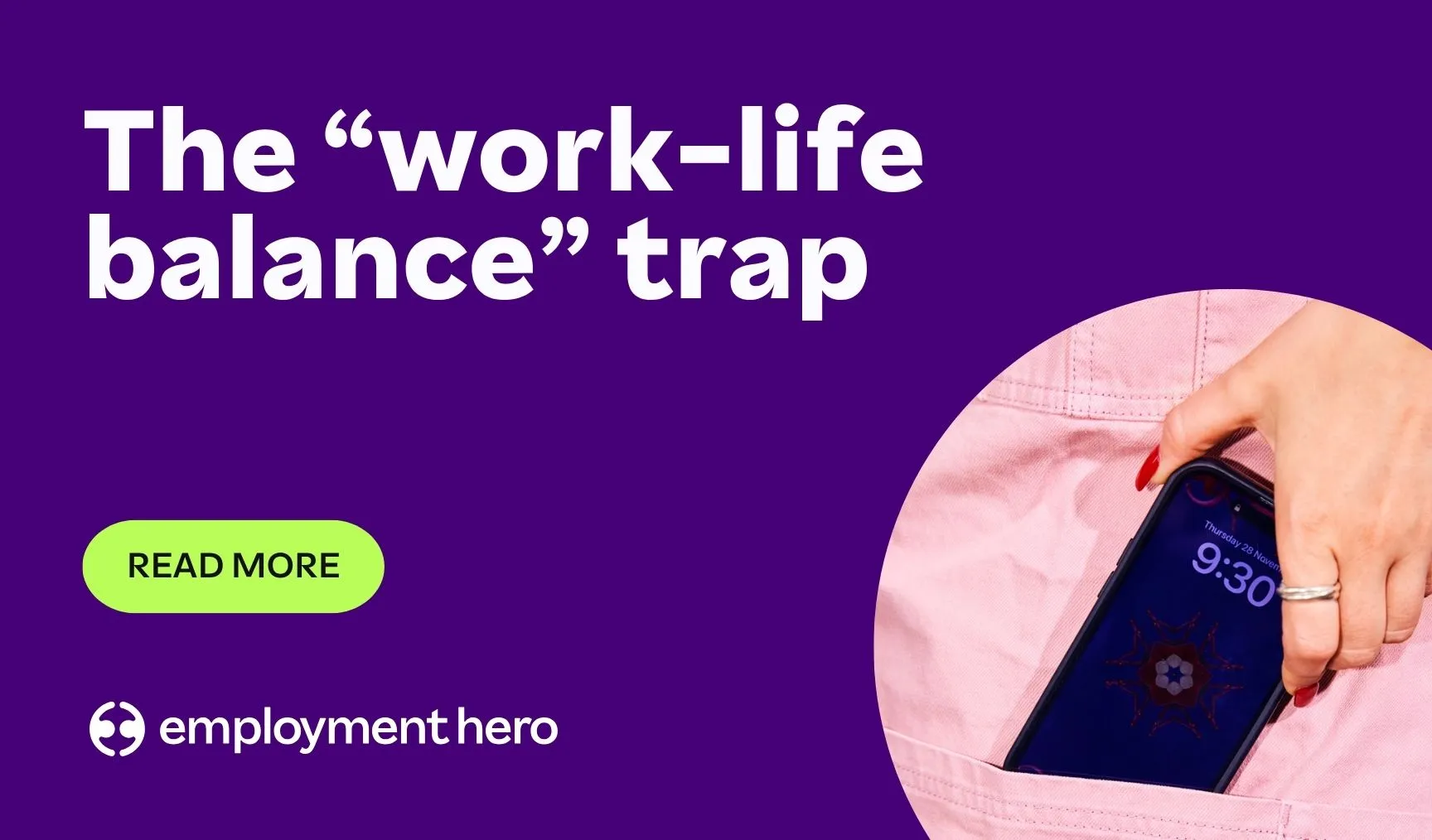 Read more: The ‘work-life balance’ trap: Why promising it is hurting your SME recruitment (and what to promise instead)
Read more: The ‘work-life balance’ trap: Why promising it is hurting your SME recruitment (and what to promise instead)The ‘work-life balance’ trap: Why promising it is hurting your SME recruitment (and what to promise instead)
For growing SMEs, work-life integration is a sustainable way to support your team and attract top talent. Explore how your…
-
 Read more: Job ad guide: How to attract top candidates
Read more: Job ad guide: How to attract top candidatesJob ad guide: How to attract top candidates
Looking to hire your perfect match? The way you pitch your open role can be the difference between landing or…
-
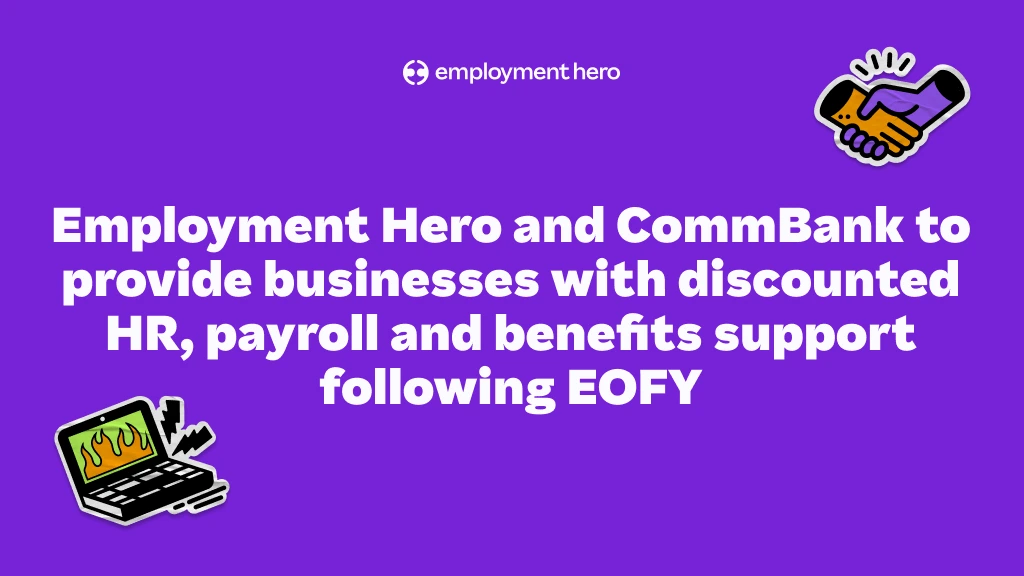 Read more: Employment Hero and CommBank to provide businesses with discounted HR, payroll and benefits support following EOFY
Read more: Employment Hero and CommBank to provide businesses with discounted HR, payroll and benefits support following EOFYEmployment Hero and CommBank to provide businesses with discounted HR, payroll and benefits support following EOFY
Eligible CommBank Yello for Business customers will get the first 3 months free on any Employment Operating System subscription with…





















